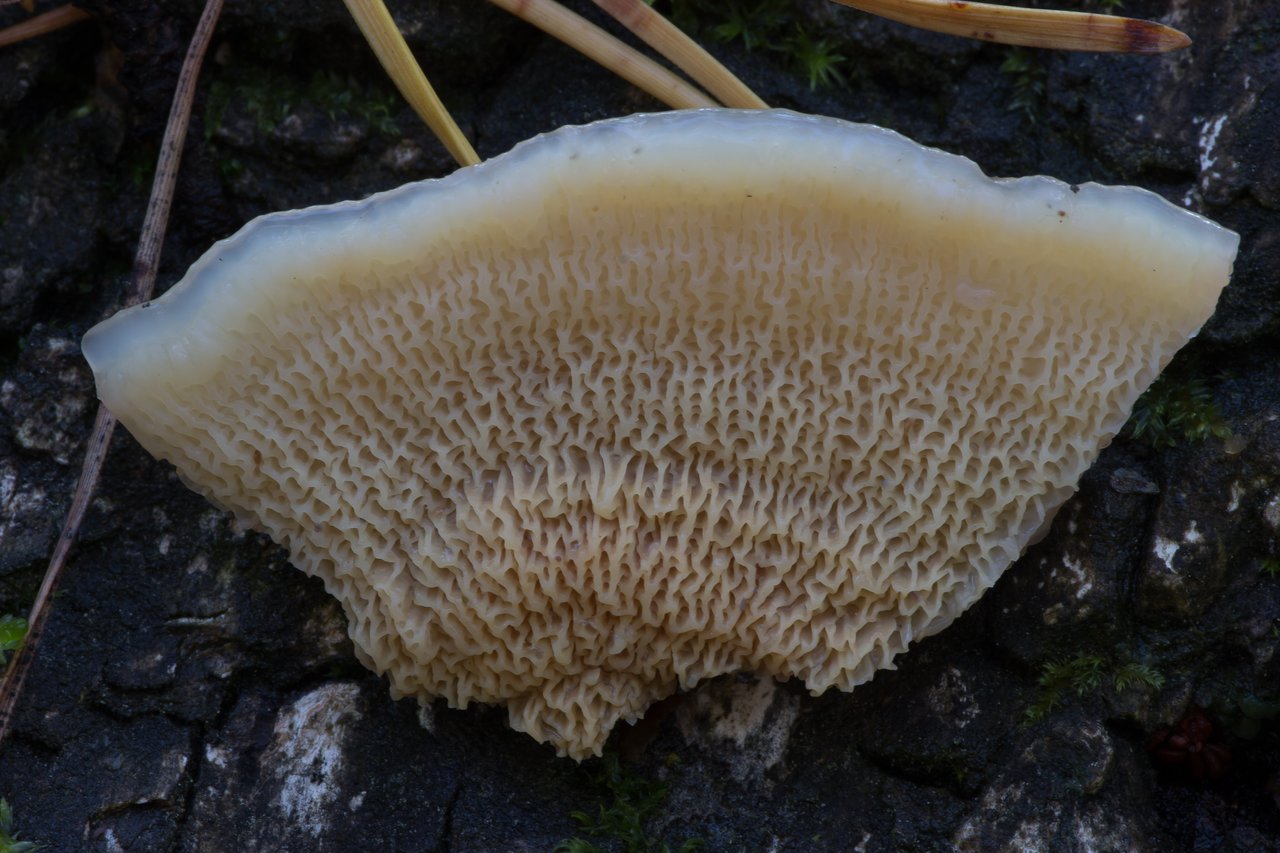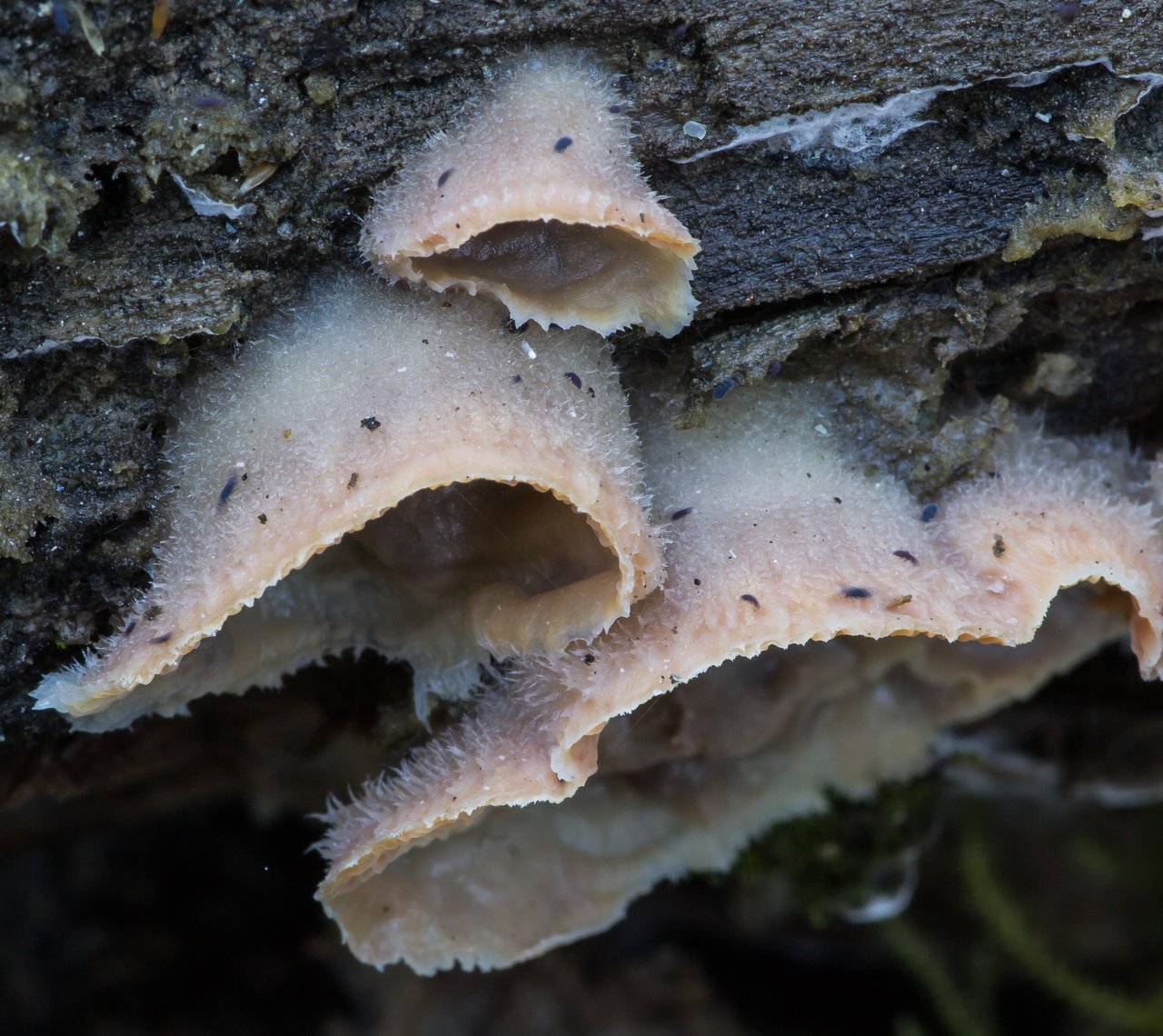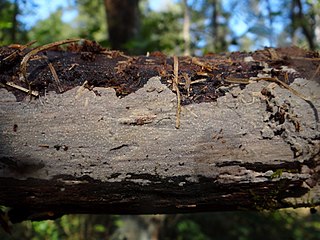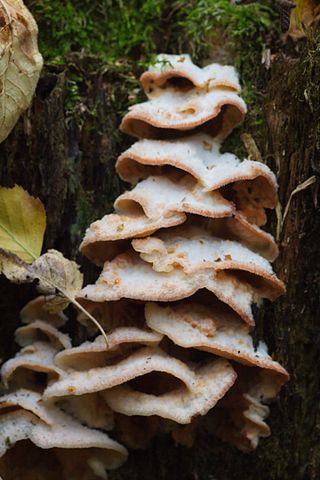Merulius trembling (Phlebia tremellosa)
Synonyms:
- Agaricus betulinus
- Xylomyzon tremellosum
- Sesia tremellosa
- Boletus arboreus

Name history:
Originally named Merulius tremellosus Schrad. (Heinrich Adolf Schrader), Spicilegium Florae Germanicae: 139 (1794)
In 1984, Nakasone and Burdsall transferred Merulius tremellosus to the genus Phlebia, Phlebia tremellosa, based on morphology and growth studies. More recently, in 2002, Moncalvo et al., Based on DNA studies, confirmed that Phlebia tremellosa belongs to the genus Phlebia.
Thus, current name: Phlebia tremellosa (Schrad.) Nakasone & Burds., Mycotaxon 21: 245 (1984)
Description
This bizarre mushroom is widespread in different continents. It can be found on dead hardwood or sometimes softwood. The typical form of Phlebia quivering is a classic example of what mycologists call "effused-reflexed" by the fruiting body: the spore-bearing surface spreads through the wood, and only a small amount of pulp appears as a slightly expanded and a tucked-in top edge.
Other distinctive features include a translucent, orange-pinkish spore-bearing surface, in which pronounced deep folds and pockets are visible, and a whitish, pubescent top edge.
Fruit body: 3-10 cm in diameter and up to 5 mm thick, irregular in shape, prostrate on the substrate with hymenium on the surface, except for a small upper "influx".
The upper tucked edge is pubescent, whitish or with a white coating. Under the bloom, the color is beige, pinkish, maybe with a yellowish tinge. As Phlebia grows quivering, its upper, turned edge acquires a slightly sinuous shape, and zoning may appear in its color.

Lower surface: translucent, often somewhat gelatinous, from orangeish to orange-pink or orange-red, to brownish in age, often has a pronounced zoning - almost white to the edge. Covered with a complex wrinkled pattern, creating the illusion of irregular porosity. The trembling merulius changes greatly with age, this is especially evident from the way the hymenophore changes. In young specimens, these are small wrinkles, folds, which then deepen, acquiring an increasingly bizarre appearance, reminiscent of a complex maze.
Leg: absent.
Flesh: whitish, very thin, elastic, slightly gelatinous. Odor and taste: no particular taste or smell.
Spore powder: White. Spores: 3.5-4.5 x 1-2 microns, smooth, smooth, non-amyloid, sausage-like, with two drops of oil.

Ecology
Saprophyte on dead deciduous wood (prefers broad-leaved) and, rarely, conifers. Fruiting bodies are solitary (rarely) or in small groups, they can grow together into rather large clusters. Cause white rot.
Season and distribution
From the second half of spring until frost. Fruiting bodies are annual, can grow on the same trunk annually until the substrate is depleted.
Merulius quivering is widespread in almost all continents.
Taxonomy
Phlebia was circumscribed by Swedish mycologist Elias Fries in his 1821 work Systema Mycologicum... He included four species: P. merismoides, P. radiata, P. contorta, and P. vaga.
Several molecular studies have demonstrated that Phlebia is a collection of sometimes unrelated taxa that share some morphological similarities. In a 2015 study, Floudas and Hibbett identified a “core Phlebia clade "within the larger Phlebioid clade, containing P. radiata, P. acerina, P. floridensis, P. setulosa, P. brevispora, and P. tremellosa... A subsequent study suggested that P. lindtneri, P. serialis and P. leptospermi should be added to this core group.
Phlebia-like fungi with aculei (spines) are often included in the genera Mycoacia if they are monomitic, and Mycoaciella if they are dimitic or trimitic.
References
- Kirk, P.M .; Cannon, P. F .; Minter, D. W .; Stalpers, J.A. (2008). Dictionary of the Fungi (10th ed.). Wallingford, UK: CAB International. p. 522. ISBN 978-0-85199-826-8.
- ^
- ^ Nakasone, K.K .; Gilbertson, R.L. (1998). "Three resupinate hydnaceous basidiomycetes from Hawaii." Folia Cryptogamica Estonica. 33: 85–92.
- Peck, C.H. (1889). Report of the Botanist (1888). Annual Report on the New York State Museum of Natural History. 42: 101–144.
- ^
- ^
- ^ Eriksson, J .; Hjortstam, K .; Ryvarden, L. (1981). The Corticiaceae of North Europe. 6. Phlebia – Sarcodontia. Oslo: Fungiflora. pp. 1048-1276.
- ^
- ^
- Duhem, B .; Michel, H. (2007). “Une espèce nouvelle de Phlebia possédant des fibers arboriformes ". Cryptogamie Mycologie (in French). 28 (1): 29–38.
- Lloyd, C.G. (1915). "Mycological Notes 39". Mycological Writings. 4 (39): 525–540.
- Hennings, P. (1897). “Beiträge zur Pilzflora Südamerikas. II ". Hedwigia (in German). 36: 190–246.
- Gilbertson, R.L .; Hemmes, D.E. (2004). "New species of lignicolous basidiomycetes from Hawaii". Memoirs of the New York Botanical Garden. 89: 81–92.
- Hjortstam, K .; Ryvarden, L. (1988). Notes on the Corticiaceae of northern China. Acta Mycologica Sinica. 7 (2): 77–88.
- Duhem, Bernard (2009). "Phlebia pyrenaica sp. nov., une nouvelle espèce méditerranéenne "[Phlebia pyrenaica sp nov., a new mediterranean species]. Cryptogamie Mycologie (in French). 30 (4): 319–328.
- Hallenberg, N .; Hjortstam, K. (1988). Studies in Corticiaceae (Basidiomycetes): new species and new combinations. Mycotaxon. 31 (2): 439–443.
- Rick, J. (1938). "Monografia das poliporineas Riograndenses". Brotéria Série Trimestral: Ciências Naturais (in Spanish). 7: 5–21.
- Hjortstam, K .; Ryvarden, L. (1980). Studies in tropical Corticiaceae (Basidiomycetes). II ". Mycotaxon. 12 (1): 168–184.
Species
Phlebia centrifuga
Phlebia coccineofulva
 Phlebia lilascens
Phlebia lilascens
 Phlebia serialis
Phlebia serialis
 Phlebia tremellosa
Phlebia tremellosa
As of May 2018, Index Fungorum accepts 89 species of Phlebia:
- P. anthocystis Gilb. & Nakasone (1998) - Hawaii
- P. acerina Peck (1889)
- P. alni Velen. (1922)
- P. amylostratosa Svrček (1973)
- P. ardesiaca Parmasto (1967)
- P. argentea Parmasto (1967)
- P. argentina (Speg.) Rajchenb. & J.E. Wright (1987)
- P. argentinensis W.B.Cooke (1956)
- P. brevibasidia G. Kaur, Avn.P.Singh & Dhingra (2017) - Punjab, India
- P. brevispora Nakasone (1981)
- P. brunneofusca (Hjortstam & Ryvarden) Nakasone & Gilb. (1998)
- P. canadensis W.B.Cooke (1956)
- P. capitata Bernicchia & Gorjón (2010)
- P. caspica Hallenb. (1980)
- P. castanea Lloyd (1922)
- P. celtidis W.B.Cooke (1956)
- P. centrifuga P. Karst. (1881)
- P. cinnamomea Rick (1960)
- P. citrea (Pat.) Nakasone (2003)
- P. coccineofulva Schwein. (1832)
- P. columellifera (G. Cunn.) Duhem (2009)
- P. crassisubiculata Avn.P. Singh, Priyanka, Dhingra & Singla (2010) - Himachal Pradesh, India
- P. cristata Velen. (1922)
- P. cystidiata H.S.Jacks. ex W.B.Cooke (1956)
- P. diaphana Parmasto ex K.H. Larss. & Hjortstam (1986)
- P. dictyophoroides Sang H. Lin & Z.C. Chen (1990)
- P. diffissa J.Erikss. & Hjortstam (1981)
- P. donkii Bourdot (1930)
- P. epithelioides P.Roberts (2000) - Cameroon
- P. faviformis W.B.Cooke (1958)
- P. femsjoeensis (Litsch. & S. Lundell) J. Erikss. & Hjortstam (1981)
- P. firma J.Erikss. & Hjortstam (1981)
- P. flavocrocea (Bres.) Donk (1957)
- P. floridensis Nakasone & Burds. (1995) - United States
- P. formosana Sheng H. Wu (1990) - Taiwan
- P. fragilis (G. Cunn.) Gorjón & Gresl. (2012)
- P. gilbertsonii Nakasone (1997)
- P. griseoflavescens (Litsch.) J. Erikss. & Hjortstam (1981) - Europe
- P. griseolivens (Bourdot & Galzin) Parmasto (1967)
- P. hydnoidea Schwein. (1832)
- P. icterina P.Roberts (2000) - Cameroon
- P. introversa (Rehill & B.K.Bakshi) Hjortstam (1995)
- P. jurassica Duhem & M.Duenas (2013) - Europe
- P. lacteola (Bourdot) M.P. Christ. (1960) - Great Britain
- P. leptospermi (G. Cunn.) Stalpers (1985) - Western Australia
- P. lilascens (Bourdot) J. Erikss. & Hjortstam (1981) - Europe
- P. livida (Pers.) Bres. (1897) - Africa; Europe; North america
- P. lividina Hjortstam (1995) - South Carolina, USA
- P. ludoviciana (Burt) Nakasone & Burds. (1982)
- P. margaritae Duhem & H. Michel (2007)
- P. merulioides Lloyd (1915)
- P. moelleriana Henn. (1897)
- P. murrillii W.B.Cooke (1956)
- P. nantahaliensis Nakasone & Burds. (1995)
- P. nitidula (P. Karst.) Ryvarden (1971)
- P. pallidolivens (Bourdot & Galzin) Parmasto (1967)
- P. parva Ghob.-Nejh. (2012)
- P. patriciae Gilb. & Hemmes (2004) - Hawaii
- P. pellucida Hjortstam & Ryvarden (1988) - China
- P. phlebioides (H.S.Jacks. & Dearden) Donk (1957)
- P. plumbea Parmasto (1967)
- P. pulcherrima Parmasto (1967)
- P. pyrenaica Duhem (2009)
- P. radiata Fr. (1821)
- P. rhodana Duhem & B. Rivoire (2014)
- P. rufa (Pers.) M.P. Christ. (1960) - Europe; Jamaica
- P. ryvardenii Hallenb. & Hjortstam (1988)
- P. sedimenticola (S. Ahmad) S. Ahmad (1972)
- P. segregata (Bourdot & Galzin) Parmasto (1967) - Europe
- P. separata (H.S.Jacks. & Dearden) Parmasto (1967)
- P. serialis (Fr.) Donk (1957) - Sweden
- P. sordida Rick (1938) - South America
- P. subceracea (Wakef.) Nakasone (2003) - Australia
- P. subconspersa (Rick) Baltazar & Rajchenb. (2016)
- P. subfascicularis (Wakef.) Nakasone & Gilb. (1998) - Australia
- P. sublilascens (Litsch.) Parmasto (1967)
- P. sublivida Parmasto (1967)
- P. subochracea (Alb. & Schwein.) J. Erikss. & Ryvarden (1976) - Europe
- P. subserialis (Bourdot & Galzin) Donk (1957) - Europe
- P. subulata J.Erikss. & Hjortstam (1981)
- P. totara (G. Cunn.) Stalpers & P.K.Buchanan (1991)
- P. tremellosa (Schrad.) Nakasone & Burds. (1984)
- P. tuberculata (Berk. & M.A. Curtis) Ţura, Zmitr., Wasser & Spirin (2011)
- P. unica (H.S.Jacks. & Dearden) Ginns (1984)
- P. verruculosa Hjortstam & Ryvarden (1980)
- P. vinosa (Overh.) Burds. (1990)
- P. viridesalebrosa J.Erikss. & Hjortstam (1981) - Europe
- P. weldeniana Nakasone & Burds. (1995)
- P. wrightii (Berk. & M.A. Curtis) Duhem (2010)






